
1. Background
Currently, with the continuous improvement of my country's urbanization level, the lack of energy and the increasing social demand for energy have become prominent contradictions that restrict the continuous progress and development of society. According to the experience of developed countries, with the continuous advancement of urbanization and the continuous improvement of people's living standards, the proportion of building energy consumption will continue to increase and reach about 33% of total energy consumption, and will eventually surpass public industry, transportation and other industries. eventually become the top source of energy consumption. Among them, the annual electricity consumption of state agency office buildings and large public buildings accounts for about 22% of the total electricity consumption in cities and towns across the country. The annual electricity consumption per square meter is 10 to 20 times that of ordinary residential buildings, which is higher than similar levels in developed countries such as Europe and Japan. 1.5 to 2 times that of the building.
In this context, based on research and practice in the energy community in the past 30 years, it is generally believed that building energy conservation is the most potential, most direct and effective way among various energy-saving approaches, and is the most effective way to alleviate the contradiction between social and economic development and insufficient energy supply. One of the measures will also become the primary factor in improving social energy usage. In this regard, it is urgent to propose a comprehensive, systematic and effective integrated energy management solution.
2. Construction Goals
This project aims to use the building energy consumption comprehensive management system to build a complete real-time management digital platform that integrates real-time measurement, statistical analysis, and management systems of building energy consumption, and realize energy consumption data on the premise of ensuring information security. Be open and transparent, and then realize energy consumption quota management and cost-free and low-cost energy consumption management, and establish a scientific energy consumption management system.
3. Overall design plan
This solution integrates cloud computing, Internet of Things technology, intelligent security isolation "firewall", and centralized management mode. It adopts a layered and distributed integrated design idea to build a reliable system on the basis of ensuring the information security of the entire system. A powerful, efficient and highly shareable energy-saving monitoring platform for public institutions. Based on a powerful public building energy consumption monitoring database, the platform realizes the informatization function of public building energy consumption monitoring, and gradually carries out energy efficiency evaluation, energy consumption standards, energy efficiency disclosure, Energy consumption quotas, energy-saving services and other businesses.
The overall architecture of the overall solution includes the field device layer, network communication layer, and monitoring management layer. Adopting a distributed system topology, the building automation system interface and the building energy consumption monitoring system network interface use the building equipment network in the weak current system as a carrier to ensure the economy and practicality of the system and avoid duplication of investment.
3.1 Field device layer:
The on-site data terminal collection equipment adopts UW2100 programmable controller. This hardware device has strong communication capabilities: it comes with RS485 communication interface, supports master-slave MODBUS-RTU protocol; supports scheduled data transmission; can be connected to electricity meters, water meters, flow meters, frequency converters etc., and can be used as an I/O remote station of DCS or PLC; has strong network capabilities: supports Ethernet/GSM wireless communication; powerful system scale: single station scale AIO: 32 points/DIO: 32 points, the system is the largest Scale AIO: 16384 points/DIO: 16384 points; and the user program code and configuration data can be permanently saved without being affected by power outages. Real-time data saving of the CPU module is optional; it follows the IEC61131-1 international configuration language standard and maintains standards While being flexible, it realizes multi-faceted transformation of algorithms, supports the concept of sub-algorithm blocks, binds algorithm primitives, and provides interfaces to support third-party algorithm access.
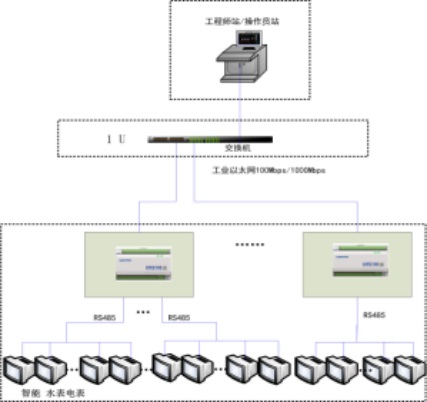
3.2 Network communication layer
Based on the powerful communication function of the UW2100 programmable controller hardware, relevant data is actively collected through the standard Modbus-RTU protocol from metering instruments with remote transmission functions installed at each energy and water point at the monitored point, and through the GPRS wireless module to GSM The communication methods are transmitted and summarized to the public institution energy-saving supervision platform for centralized and comprehensive processing. GPRS is a new type of mobile communication service that establishes a connection between mobile users and data networks to provide mobile users with high-speed wireless IP or X.25 services. GPRS uses packet switching technology. Each user can occupy multiple Wireless channel. At the same time, a wireless channel can be shared by multiple users. Resources are effectively utilized. The data interpretation rate is as high as 160Kbps. GPRS communication is used to realize packet sending and receiving of data. Users are always online and billed according to traffic. It is high-speed and Reduce service costs.
The building energy consumption and energy saving supervision and security system based on GPRS has the following characteristics:
a) Always online: GPRS DTU can automatically attach to the GPRS network as soon as it is turned on, and establish a communication link with the data center to accept data from user data devices at any time. It is powerful and has high real-time performance;
b) Billing by traffic: GPRS DTU is always online, and charges are based on the number of data packets received and sent. There is no charge when there is no data traffic, saving costs;
c) High-speed transmission The transmission speed of the GPRS network can reach up to 160Kbps at the fastest. The speed depends on the network settings of the mobile operator. According to China Mobile's network conditions, it can currently provide stable data transmission of 20~40 Kbps;
d) Networking is simple, fast and flexible. The GPRS wireless system can build a virtual mobile communication network covering the whole of China anytime and anywhere through the Internet network, providing access convenience for the majority of small and medium-sized users and saving access investment.
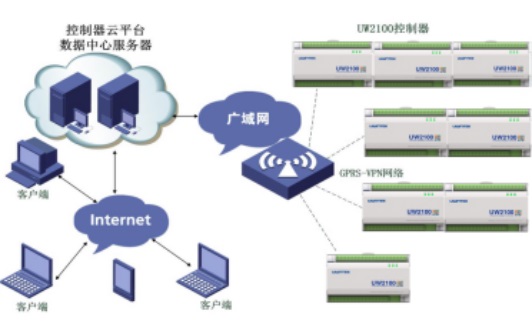
3.3 Monitoring management
The public institution energy-saving supervision platform is based on UWin Pro monitoring and management software with independent intellectual property rights of Hangzhou Youwen Automation System Co., Ltd. for centralized analysis, judgment, evaluation, management, recording, etc. UWin Pro monitoring and management software integrates project manager (UWinWks), system hardware configuration software (UWinCFG), real-time database (UWinRDB), historical record configuration (UWinHDB), device manager (UWinDev), screen development system (UWinView), and alarm Configuration management software (UWinAlarm), algorithm editor (UWinIEC), time series analysis software (UWinSOE), and WEB server (UWinWEB) are integrated into one. A single software can realize on-site data collection, algorithm execution, real-time database and historical data processing. Alarm and safety mechanisms, process control, screen display, trend curve and report output, and monitoring network functions. Each part runs on different hardware platforms respectively, and interacts with various data, management and control information through the control network and system network to coordinately complete various functions of the entire building energy consumption and energy saving supervision and safety system.
4. System functions
The building energy consumption and energy saving supervision and safety system integrates monitoring, control and management. Mainly implements the following functions:
1) Comprehensively manage all types of energy-consuming equipment, establish a panoramic database, collect energy consumption monitoring data, and establish an energy consumption data model to provide a data basis for later energy consumption data analysis and energy-saving diagnosis.
2) Carry out statistical analysis of energy consumption data to analyze, judge and evaluate the composition, change patterns and energy utilization efficiency of energy consumption, etc., to provide qualitative or quantitative basis for the evaluation of the effects of later energy-saving renovations.
3) Based on the results of energy consumption data analysis, determine the energy consumption level, propose a complete diagnostic process for energy consumption, carry out energy-saving diagnosis work, and obtain energy-saving diagnosis results.
4) Integrate various building management systems, establish an energy consumption evaluation system, optimize the design of building energy conservation based on energy-saving diagnosis results, and come up with energy-saving renovation plans.
5) Implement energy-saving plans, transform energy-using equipment, manage energy-using habits, and fully achieve building energy-saving goals through intelligent control systems.
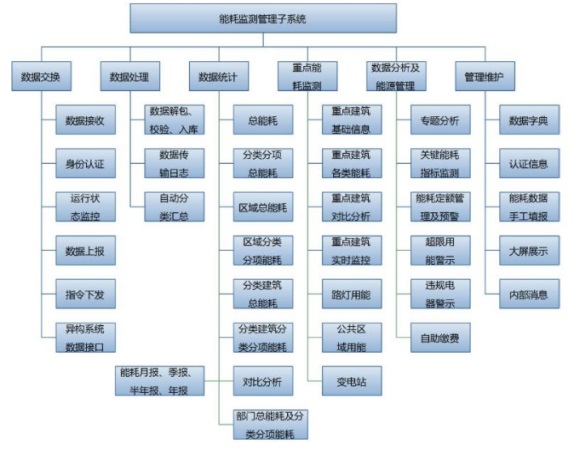
Building energy consumption and energy saving supervision and safety system function tree
5. Monitoring interface
The monitoring interface of the public institution energy-saving supervision platform constructed this time mainly includes: energy consumption overview, map overview, basic information, energy consumption dynamics, building energy consumption analysis, public institution energy consumption analysis, administrative area energy consumption analysis, energy consumption assessment, Energy consumption receiving and uploading, system management. Through these functional modules, the collection, monitoring, statistics, analysis, and diagnosis of energy consumption data can be realized, providing strong data support and scientific basis for energy management and energy-saving renovation of public buildings in the administrative center.

Building energy consumption and energy saving supervision and safety system general monitoring interface
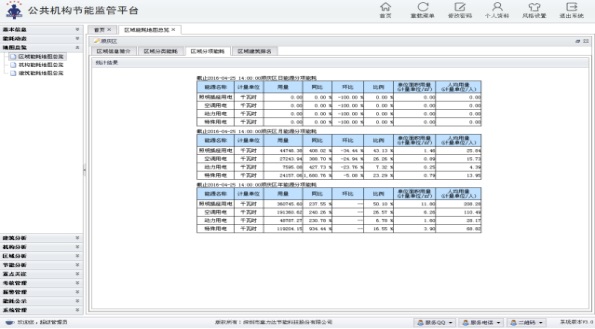
Building energy consumption and energy saving supervision and safety system regional sub-monitoring interface
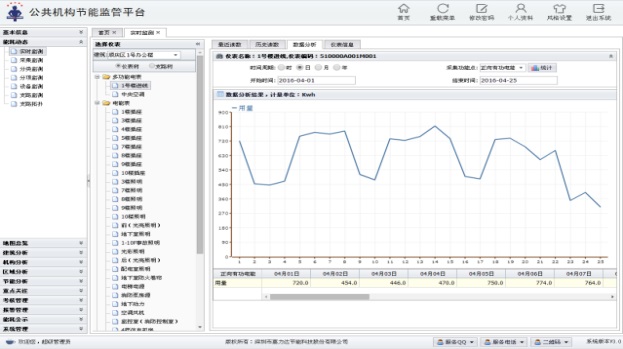
Real-time monitoring-data analysis screenshots
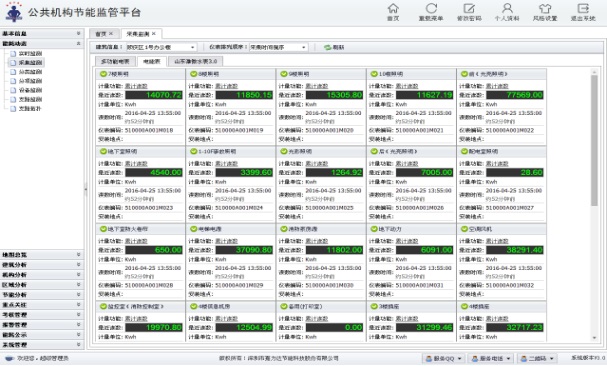
Collection monitoring monitoring interface
